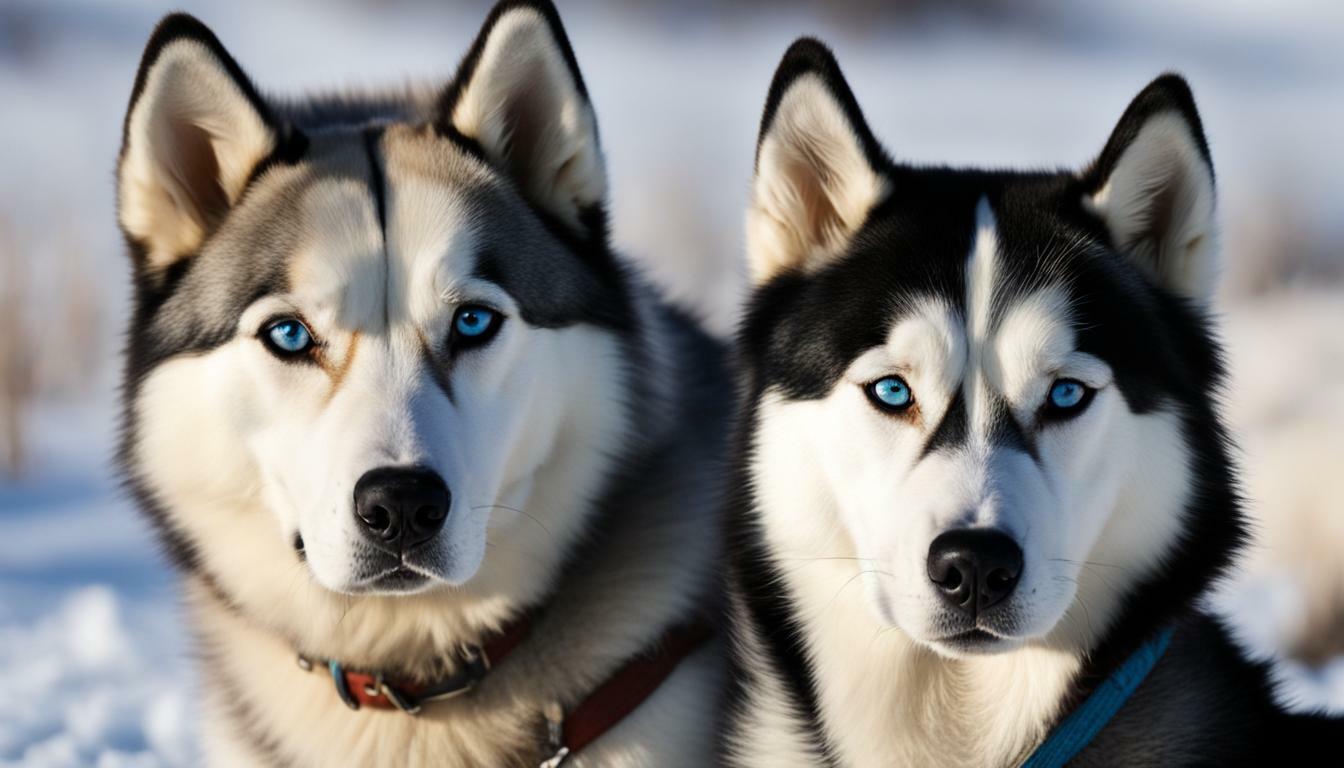Are you curious about the differences and similarities between Huskies and Siberian Huskies? Unleash the mystery behind these beloved dog breeds in this comprehensive guide.
Huskies and Siberian Huskies are medium-sized sled dog breeds that originated in Siberia. They have thick fur coats, pointed ears, and striking blue or brown eyes. Siberian Huskies were originally bred for working in teams to pull sleds over long distances. They are intelligent, athletic, and independent dogs. They have a friendly and outgoing temperament and get along well with other dogs and humans. Siberian Huskies require regular grooming and plenty of exercise to stay healthy. They are generally a healthy breed but can be prone to health issues such as hip dysplasia and eye disorders.
Huskies are energetic and need lots of physical and mental exercise. Labrador Retrievers, on the other hand, are also energetic and intelligent but have a calmer and more playful temperament. They are well-suited to families, as they are good with children and enjoy being around people. Labradors have a shorter coat and shed year-round but require regular grooming. Both breeds have their own traits, and choosing the right one depends on the individual’s lifestyle and preferences.
Understanding the Origins of Huskies and Siberian Huskies
To understand the characteristics of Huskies and Siberian Huskies, it’s important to delve into their fascinating origins and the roles they played in the past. These medium-sized sled dog breeds originated in Siberia, where they were developed by the indigenous Chukchi people for their ability to withstand harsh Arctic conditions and pull sleds over long distances.
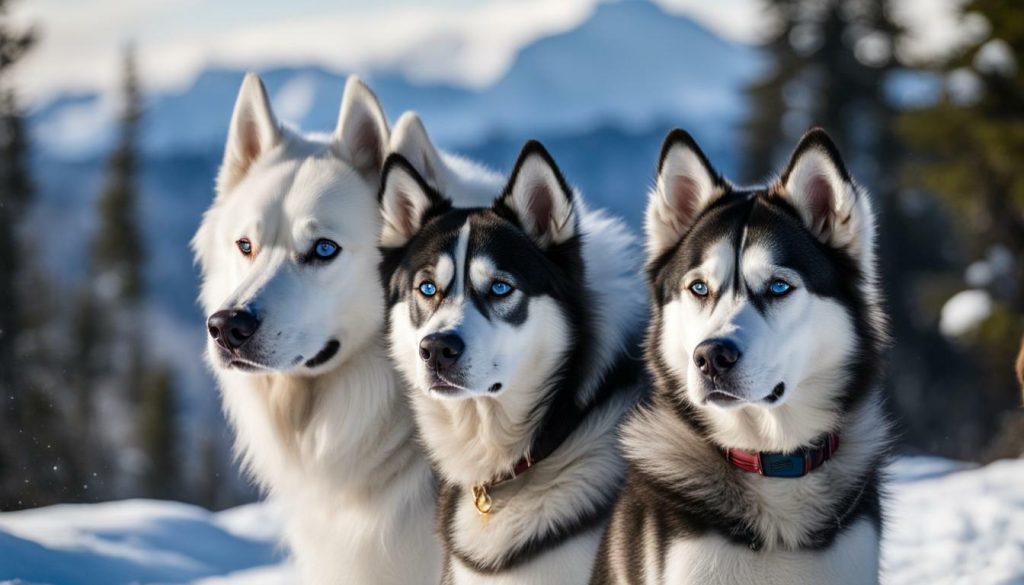
The Siberian Husky, specifically, was bred by the Chukchi people as a working dog to transport goods and travel long distances swiftly. Their impressive endurance and speed made them invaluable in the harsh Siberian environment. Siberian Huskies are known for their intelligence, athleticism, and independent nature, which were essential traits for their role as sled dogs.
On the other hand, Huskies, which refers to a broader category of sled dog breeds, have also played a significant role in sled pulling and transportation. However, unlike Siberian Huskies, they were bred by various Arctic cultures, including the Inuit and the Sami people. These cultures developed different strains of Huskies tailored to their specific needs, resulting in variations in appearance and temperament.
| Husky Breed | Siberian Husky Breed |
|---|---|
| Developed by various Arctic cultures including the Inuit and the Sami people | Developed by the indigenous Chukchi people |
| Variations in appearance and temperament based on regional needs | Distinct appearance with thick fur coats, pointed ears, and striking blue or brown eyes |
| Play a crucial role in sled pulling and transportation | Originally bred as working dogs to transport goods and travel long distances swiftly |
“The Chukchi people developed the Siberian Husky for its endurance, speed, and independent nature, which were essential traits for their role as sled dogs.”
Summarizing the Origins
In summary, Huskies and Siberian Huskies have fascinating origins rooted in their development by various Arctic cultures and indigenous peoples. While Huskies were adapted to meet the specific needs of different regions, Siberian Huskies were specifically bred by the Chukchi people for their endurance, speed, and independence. Understanding these origins can provide valuable insights into the characteristics and traits of these beloved dog breeds today.
Exploring the Physical Traits of Huskies and Siberian Huskies
Huskies and Siberian Huskies possess unique physical traits that set them apart from each other, making it easy to identify which breed is which. Let’s dive into the distinctive characteristics of each breed.
Physical Traits of Huskies
Huskies are well-known for their dense double coat, which keeps them warm in cold climates. Their fur comes in a variety of colors, including black, gray, sable, and white. One striking feature of Huskies is their eyes. They can have blue eyes, brown eyes, or even one of each, which adds to their captivating appearance.
In addition to their fur and eyes, Huskies have erect, triangular-shaped ears that help regulate their body temperature. Their tails are fluffy and often curl over their backs. With a medium-sized build, Huskies are strong and agile, suited for pulling sleds and working in snowy conditions.
Physical Traits of Siberian Huskies
Siberian Huskies share some similarities with their Husky counterparts, but they also have distinct features. Like Huskies, they have a double coat, but their fur tends to be shorter and less dense. Siberian Huskies come in various colors, including black, gray, red, and white. However, their most recognizable feature is their striking almond-shaped eyes, which can be blue, brown, or a combination.
When it comes to ears and tails, Siberian Huskies have erect ears that are slightly rounded at the tips, giving them an alert and curious expression. Their tails are bushy and carried in a gentle curve over their backs. Siberian Huskies have a lean and athletic build, indicating their stamina and ability to cover long distances.
| Physical Traits | Huskies | Siberian Huskies |
|---|---|---|
| Coat | Dense, double coat in various colors | Shorter, less dense double coat in various colors |
| Eyes | Blue, brown, or heterochromatic | Blue, brown, or heterochromatic |
| Ears | Erect and triangular-shaped | Erect and slightly rounded at the tips |
| Tail | Fluffy and typically curled over the back | Bushy and carried in a gentle curve over the back |
| Build | Medium-sized, strong, and agile | Lean and athletic |
Understanding the physical traits of Huskies and Siberian Huskies allows us to appreciate the unique beauty and functional qualities of each breed.
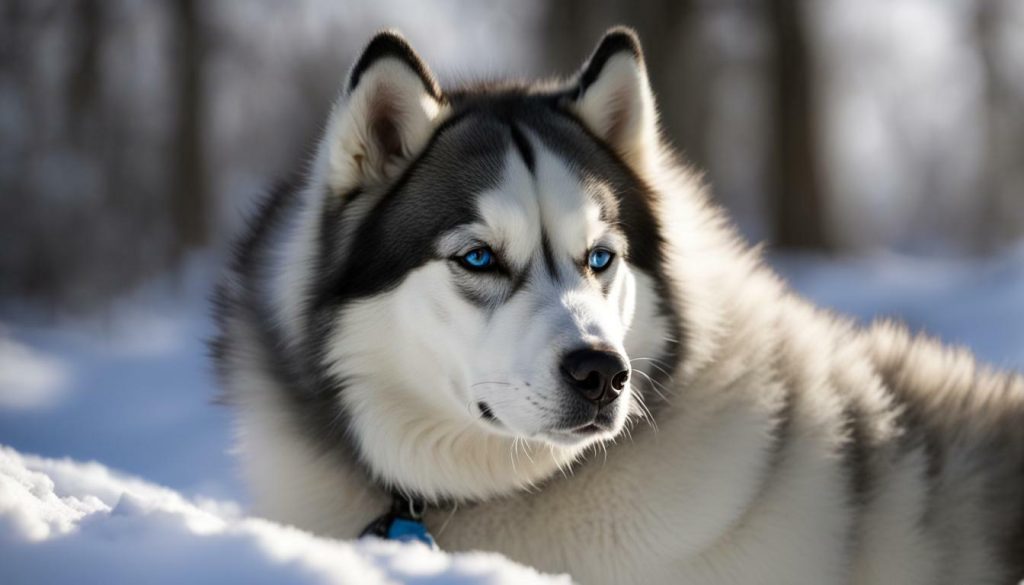
Remember, when considering a furry companion, it’s essential to assess not just the physical traits but also the overall temperament and specific needs of the breed. The next section will delve into the temperament of Huskies and Siberian Huskies, shedding light on what makes these breeds truly special.
Unraveling the Temperament of Huskies and Siberian Huskies
When it comes to temperament, Huskies and Siberian Huskies have their own distinctive personalities that make them lovable and sometimes challenging pets. Both breeds are known for their intelligence, independence, and sociability.
Siberian Huskies are friendly and outgoing dogs. They enjoy being around people and get along well with other dogs. Their sociable nature makes them great companions for families and individuals alike. However, their independent streak can sometimes create challenges when it comes to training. They are known for being intelligent dogs, but they may require consistent and patient training methods to fully unleash their potential.
Huskies, on the other hand, are energetic and highly active. They have a strong prey drive, which means they may not be the best fit for households with small pets. Huskies thrive in environments where they have plenty of physical and mental exercise. They are known for their playful and mischievous nature, which can be both endearing and challenging. Like Siberian Huskies, Huskies are intelligent dogs, but they may require consistent training and socialization to prevent behavioral issues.
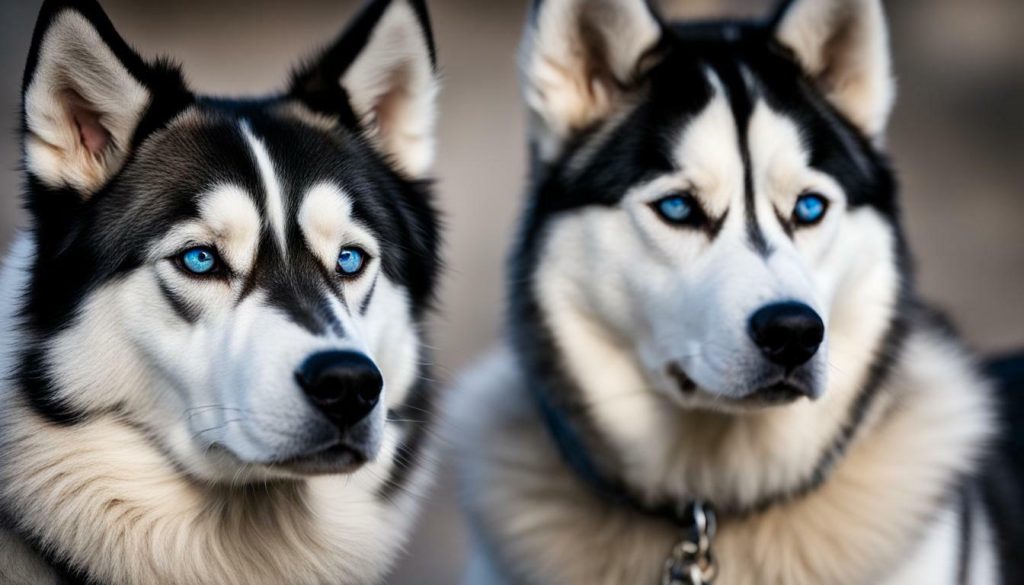
In conclusion, the temperament of Huskies and Siberian Huskies reflects their unique heritage and purpose. While both breeds can make wonderful pets, it is important to consider their individual needs and temperaments before deciding which one is the right fit for you. Training, socialization, and providing ample exercise are essential for raising a well-rounded and happy Husky or Siberian Husky.
Comparing the Size and Exercise Needs of Huskies and Siberian Huskies
Size and exercise needs play a significant role in determining which breed of dog is the right fit for your lifestyle. Let’s explore the specifics of Huskies and Siberian Huskies in this regard.
Huskies and Siberian Huskies are medium-sized sled dog breeds, known for their athletic builds and high energy levels. On average, Huskies can reach a height of 20 to 23.5 inches (51 to 60 cm) at the shoulder and weigh between 35 to 60 pounds (16 to 27 kg), while Siberian Huskies are slightly smaller, measuring 20 to 23.5 inches (51 to 60 cm) in height and weighing between 35 to 50 pounds (16 to 23 kg). It’s important to note that individual sizes may vary within each breed.
When it comes to exercise, both breeds require regular physical activity to stay happy and healthy. Huskies and Siberian Huskies are highly active and need plenty of mental and physical stimulation. They are known for their endurance and love for outdoor adventures. Daily exercise should include long walks, engaging play sessions, and opportunities for them to run and explore off-leash in a safe environment. Lack of exercise can lead to behavioral problems, such as excessive digging or howling.
It’s vital to provide Huskies and Siberian Huskies with outlets for their energy and strong working instincts. Obedience training, agility exercises, and interactive toys can help keep them mentally stimulated. Engaging in activities like hiking, jogging, or participating in dog sports such as sledding or agility training can be great ways to meet their exercise needs.
| Husky | Siberian Husky | |
|---|---|---|
| Average Height | 20-23.5 inches (51-60 cm) | 20-23.5 inches (51-60 cm) |
| Average Weight | 35-60 pounds (16-27 kg) | 35-50 pounds (16-23 kg) |
| Exercise Needs | High | High |
“The bond with a true dog is as lasting as the ties of this earth will ever be.” – Konrad Lorenz
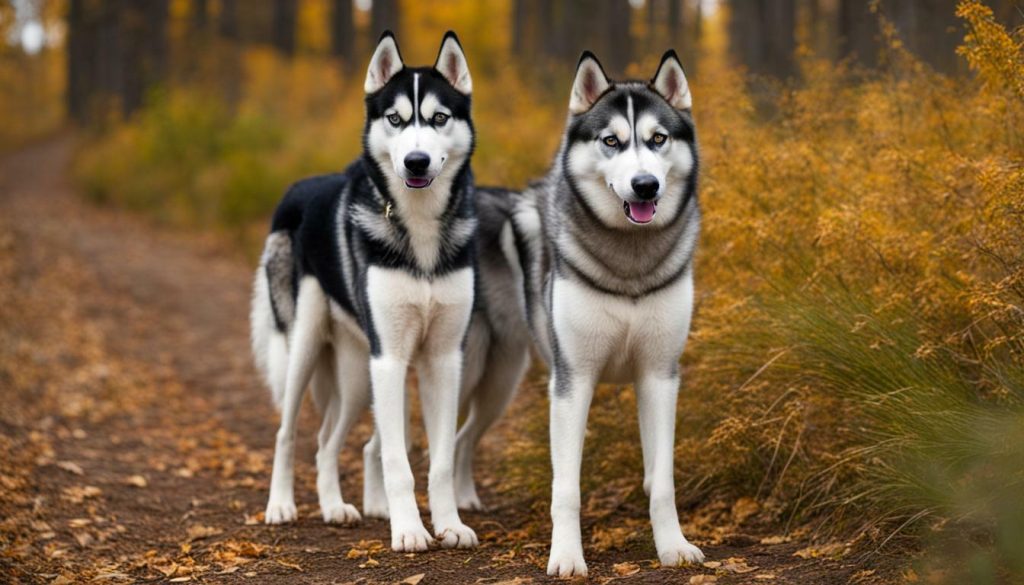
Size and exercise needs are important factors to consider when choosing between Huskies and Siberian Huskies. If you have a more active lifestyle and can provide the necessary exercise and mental stimulation, both breeds can be wonderful companions. However, keep in mind that they may not be suitable for individuals with limited space or those who cannot commit to regular exercise routines.
Remember, every dog is unique, and while size and exercise needs may provide a general guideline, it’s crucial to assess the individual dog’s personality, behavior, and health to ensure a compatible match for your lifestyle.
Managing Shedding in Huskies and Siberian Huskies
Shedding is a common concern for dog owners, particularly those considering Huskies or Siberian Huskies. These beautiful breeds have thick fur coats that require regular grooming to keep them healthy and looking their best. By understanding their shedding patterns and implementing a consistent grooming routine, you can effectively manage the shedding and keep your home clean.
Huskies and Siberian Huskies are known to shed heavily twice a year, during spring and fall, as they prepare for seasonal temperature changes. This process, known as “blowing their coat,” involves the shedding of their dense undercoat to make way for a lighter, cooler coat. During this time, you may notice an increase in shedding and fur around your home.
To manage shedding in Huskies and Siberian Huskies, regular brushing is essential. Using a high-quality deshedding tool or slicker brush, gently remove loose fur from their coat. This not only helps reduce shedding but also promotes healthy skin and circulation. Aim to brush your dog at least once a week, increasing the frequency during shedding season.
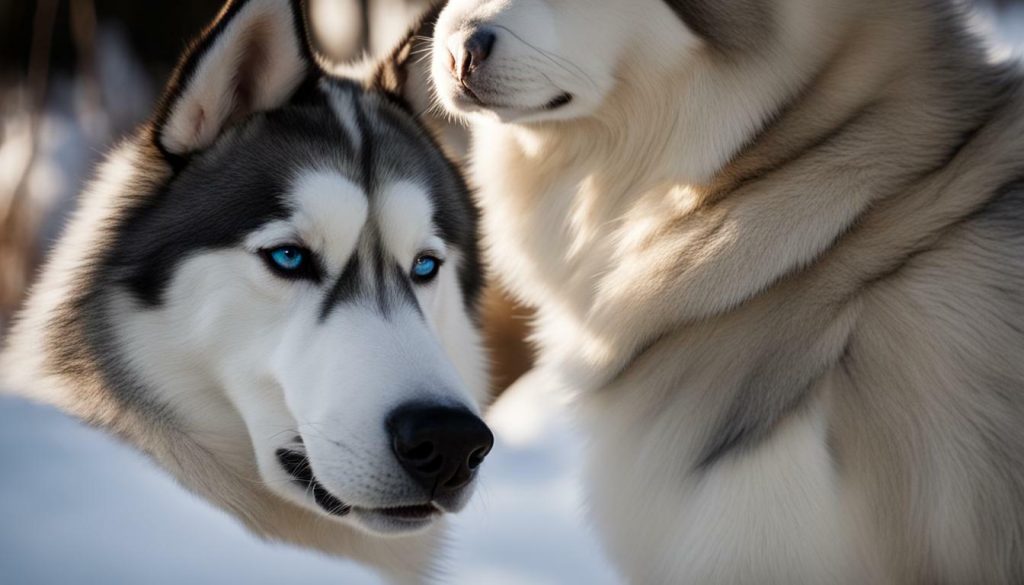
| Grooming Tips for Managing Shedding |
|---|
| 1. Use a deshedding tool or slicker brush to remove loose fur. |
| 2. Bathe your dog regularly with a gentle shampoo to keep their coat clean and healthy. |
| 3. Consider using a shedding control supplement or adding omega-3 fatty acids to their diet to improve coat health. |
| 4. Keep your dog hydrated by providing fresh water at all times. |
| 5. Vacuum and sweep your home frequently to prevent fur buildup. |
“Regular grooming and a consistent brushing routine are key to managing shedding in Huskies and Siberian Huskies. By dedicating time to maintain their coat and implementing these tips, you can minimize shedding and keep your furry friend looking their best.” – Dog Grooming Expert
Grooming and Health Considerations for Huskies and Siberian Huskies
Maintaining proper grooming and keeping an eye on your dog’s health are essential responsibilities for Husky and Siberian Husky owners. Let’s dive into the specifics.
Both Huskies and Siberian Huskies have thick double coats that require regular brushing to keep them looking their best. They shed heavily twice a year, known as blowing their coat, during which time daily brushing is necessary to prevent matting and minimize shedding.
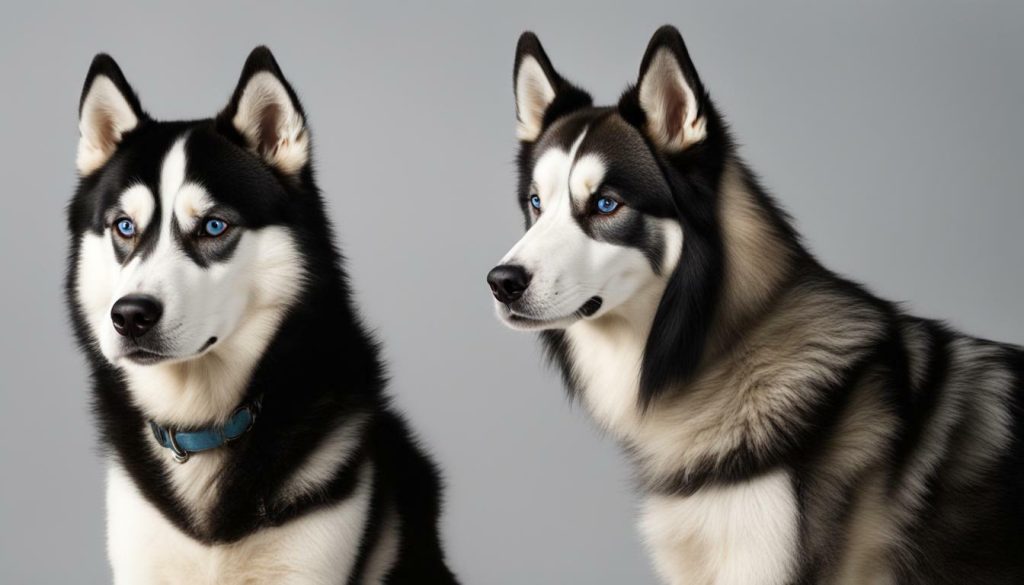
In addition to regular brushing, regular bathing is important to keep your Husky or Siberian Husky clean and odor-free. Use a dog-specific shampoo and make sure to thoroughly rinse off all soap to avoid skin irritations.
When it comes to health considerations, both breeds are generally healthy with a few breed-specific concerns. Siberian Huskies are prone to hip dysplasia, an inherited condition that affects the hip joints, and eye disorders such as cataracts and progressive retinal atrophy. Regular eye examinations by a veterinarian are recommended to monitor and detect any early signs of these conditions.
Huskies, on the other hand, may be prone to certain genetic disorders such as epilepsy and autoimmune disorders. Regular check-ups with a veterinarian and preventive measures such as vaccinations and parasite control are crucial to ensure your Husky or Siberian Husky stays healthy.
In summary, proper grooming and healthcare are vital for Husky and Siberian Husky owners. Regular brushing, bathing, and keeping an eye out for potential health issues will help keep your beloved furry companions looking and feeling their best.
Similarities and Differences Between Huskies and Siberian Huskies
Now that we’ve explored the individual traits of Huskies and Siberian Huskies, it’s time to bring them together and compare their similarities and differences side by side.
One of the key similarities between the two breeds is their physical appearance. Both Huskies and Siberian Huskies are medium-sized dogs with thick fur coats that help them endure cold weather. They both have pointed ears and striking blue or brown eyes, adding to their distinctive and captivating look.
However, there are also notable differences between the two breeds. Siberian Huskies were originally bred for working purposes, specifically pulling sleds over long distances. As a result, they are known for their athleticism and endurance. On the other hand, Huskies are energetic and require plenty of physical and mental exercise, but they do not have the same level of working stamina as Siberian Huskies.
Grooming is another area where the two breeds differ. Siberian Huskies require regular grooming to maintain their thick coats, while Huskies have a shorter coat and shed year-round. Both breeds benefit from regular brushing to keep their fur healthy and minimize shedding.
| Similarities between Huskies and Siberian Huskies | Differences between Huskies and Siberian Huskies |
|---|---|
| Medium-sized sled dog breeds | Siberian Huskies bred for working in teams |
| Thick fur coats and striking eyes | Huskies have shorter coats and shed year-round |
| Friendly and outgoing temperaments | Siberian Huskies require regular grooming |
| Intelligent and independent | Siberian Huskies known for athleticism and endurance |
Overall, Huskies and Siberian Huskies share several similarities in their physical traits and temperaments. However, their differences in working abilities, grooming needs, and energy levels make each breed unique. When deciding between a Husky and a Siberian Husky, it’s important to consider your own lifestyle and preferences to find the perfect fit for you and your family.
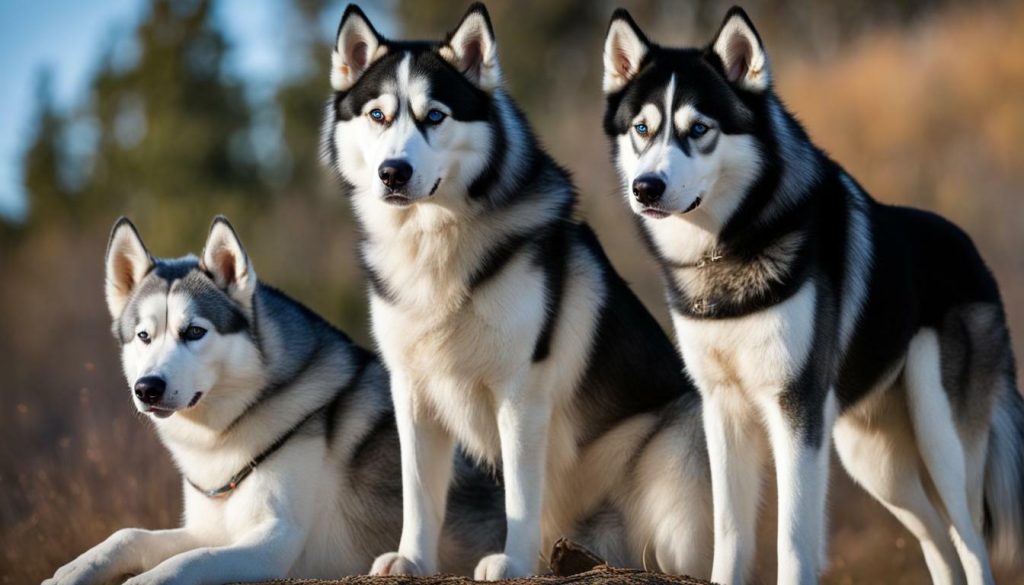
- Huskies and Siberian Huskies have similar physical appearances, such as medium size, thick fur coats, and striking eyes.
- Siberian Huskies were bred for working purposes, while Huskies are known for their energy and exercise needs.
- Siberian Huskies require regular grooming, while Huskies have shorter coats and shed year-round.
- Consider your own lifestyle and preferences when choosing between a Husky and a Siberian Husky.
Choosing the Right Breed for You: Factors to Consider
With all the information you’ve gathered throughout this guide, it’s time to make the crucial decision of selecting either a Husky or a Siberian Husky as your new four-legged companion. Both breeds have their own unique traits and characteristics that may appeal to different individuals, so it’s important to consider a few factors before making your final choice.
First and foremost, think about your lifestyle and the amount of time and energy you can dedicate to your new furry friend. Huskies and Siberian Huskies are both energetic and require plenty of exercise to stay happy and healthy. If you enjoy an active lifestyle and have ample time for long walks, runs, or outdoor activities, either breed can be a great fit. However, if you have a more laid-back lifestyle or limited time for exercise, you may find a Siberian Husky to be a better match, as they generally have a slightly lower energy level compared to Huskies.
Another factor to consider is the grooming requirements of each breed. Both Huskies and Siberian Huskies have thick double coats that shed heavily, especially during certain seasons. Regular brushing and grooming are essential to keep their coats healthy and to minimize shedding around your home. If you have allergies or simply prefer a breed that requires less grooming, you may lean towards a shorter-coated breed or be prepared to invest in the necessary grooming tools and techniques.
Lastly, consider your personal preferences and the specific traits that resonate with you. While Huskies and Siberian Huskies share many similarities, they do have some distinct differences in temperament. Huskies tend to be more independent and may exhibit a stronger prey drive, which means they may not be as reliable off-leash as Siberian Huskies. On the other hand, Siberian Huskies are known for their friendly and sociable nature, getting along well with both humans and other dogs. If you prioritize a dog that easily integrates into your family and is highly social, a Siberian Husky might be the better choice for you.
Ultimately, the decision between a Husky and a Siberian Husky comes down to your lifestyle, preferences, and the specific needs of your future companion. Consider the exercise requirements, grooming needs, and temperament of each breed, and make an informed choice that aligns with your capabilities and desires. Whichever breed you choose, both Huskies and Siberian Huskies are loving, loyal, and beautiful dogs that can bring immense joy and companionship to your life.
FAQ
Q: What is the difference between a Husky and a Siberian Husky?
A: Huskies and Siberian Huskies are actually the same breed. The terms “Husky” and “Siberian Husky” are often used interchangeably to refer to this medium-sized sled dog breed that originated in Siberia.
Q: What are the physical traits of Huskies and Siberian Huskies?
A: Both Huskies and Siberian Huskies have thick fur coats, pointed ears, and striking blue or brown eyes. These physical characteristics help them adapt to cold weather conditions.
Q: What is the temperament of Huskies and Siberian Huskies?
A: Huskies and Siberian Huskies are intelligent, athletic, and independent dogs. They have a friendly and outgoing temperament, getting along well with other dogs and humans.
Q: How much exercise do Huskies and Siberian Huskies need?
A: Both Huskies and Siberian Huskies are energetic breeds that require lots of physical and mental exercise to stay healthy. Regular exercise is crucial for their well-being and overall happiness.
Q: Do Huskies and Siberian Huskies shed a lot?
A: Yes, both Huskies and Siberian Huskies shed year-round. Their thick fur coats require regular grooming to manage shedding and keep their coats clean.
Q: Are there any health considerations for Huskies and Siberian Huskies?
A: While both breeds are generally healthy, Huskies and Siberian Huskies can be prone to health issues such as hip dysplasia and eye disorders. Regular veterinary check-ups are important to monitor their health.
Q: What are the similarities and differences between Huskies and Siberian Huskies?
A: Huskies and Siberian Huskies share many physical and temperamental traits. However, the term “Husky” is often used to refer to any sled dog type, while “Siberian Husky” specifically refers to the breed that originated in Siberia.
Q: How do I choose between a Husky and a Siberian Husky?
A: Choosing the right breed depends on your lifestyle and preferences. Consider factors such as exercise needs, grooming requirements, and temperament to make an informed decision that suits your individual needs.
